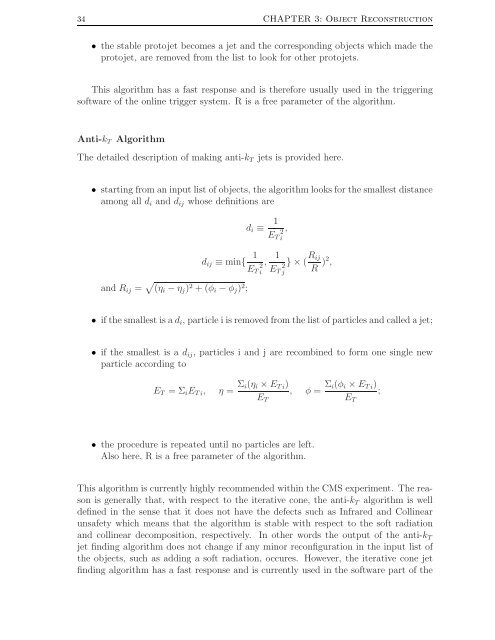Measurement of the Jet Energy Scale in the CMS experiment ... - IIHE
Measurement of the Jet Energy Scale in the CMS experiment ... - IIHE
Measurement of the Jet Energy Scale in the CMS experiment ... - IIHE
Create successful ePaper yourself
Turn your PDF publications into a flip-book with our unique Google optimized e-Paper software.
34 CHAPTER 3: Object Reconstruction• <strong>the</strong> stable protojet becomes a jet and <strong>the</strong> correspond<strong>in</strong>g objects which made <strong>the</strong>protojet, are removed from <strong>the</strong> list to look for o<strong>the</strong>r protojets.This algorithm has a fast response and is <strong>the</strong>refore usually used <strong>in</strong> <strong>the</strong> trigger<strong>in</strong>gs<strong>of</strong>tware <strong>of</strong> <strong>the</strong> onl<strong>in</strong>e trigger system. R is a free parameter <strong>of</strong> <strong>the</strong> algorithm.Anti-k T AlgorithmThe detailed description <strong>of</strong> mak<strong>in</strong>g anti-k T jets is provided here.• start<strong>in</strong>g from an <strong>in</strong>put list <strong>of</strong> objects, <strong>the</strong> algorithm looks for <strong>the</strong> smallest distanceamong all d i and d ij whose def<strong>in</strong>itions areand R ij = √ (η i − η j ) 2 + (φ i − φ j ) 2 ;d i ≡ 12E T id ij ≡ m<strong>in</strong>{ 1 12,2} × ( R ijE T i E T jR )2 ,,• if <strong>the</strong> smallest is a d i , particle i is removed from <strong>the</strong> list <strong>of</strong> particles and called a jet;• if <strong>the</strong> smallest is a d ij , particles i and j are recomb<strong>in</strong>ed to form one s<strong>in</strong>gle newparticle accord<strong>in</strong>g toE T = Σ i E T i , η = Σ i(η i × E T i )E T, φ = Σ i(φ i × E T i )E T;• <strong>the</strong> procedure is repeated until no particles are left.Also here, R is a free parameter <strong>of</strong> <strong>the</strong> algorithm.This algorithm is currently highly recommended with<strong>in</strong> <strong>the</strong> <strong>CMS</strong> <strong>experiment</strong>. The reasonis generally that, with respect to <strong>the</strong> iterative cone, <strong>the</strong> anti-k T algorithm is welldef<strong>in</strong>ed <strong>in</strong> <strong>the</strong> sense that it does not have <strong>the</strong> defects such as Infrared and Coll<strong>in</strong>earunsafety which means that <strong>the</strong> algorithm is stable with respect to <strong>the</strong> s<strong>of</strong>t radiationand coll<strong>in</strong>ear decomposition, respectively. In o<strong>the</strong>r words <strong>the</strong> output <strong>of</strong> <strong>the</strong> anti-k Tjet f<strong>in</strong>d<strong>in</strong>g algorithm does not change if any m<strong>in</strong>or reconfiguration <strong>in</strong> <strong>the</strong> <strong>in</strong>put list <strong>of</strong><strong>the</strong> objects, such as add<strong>in</strong>g a s<strong>of</strong>t radiation, occures. However, <strong>the</strong> iterative cone jetf<strong>in</strong>d<strong>in</strong>g algorithm has a fast response and is currently used <strong>in</strong> <strong>the</strong> s<strong>of</strong>tware part <strong>of</strong> <strong>the</strong>
















